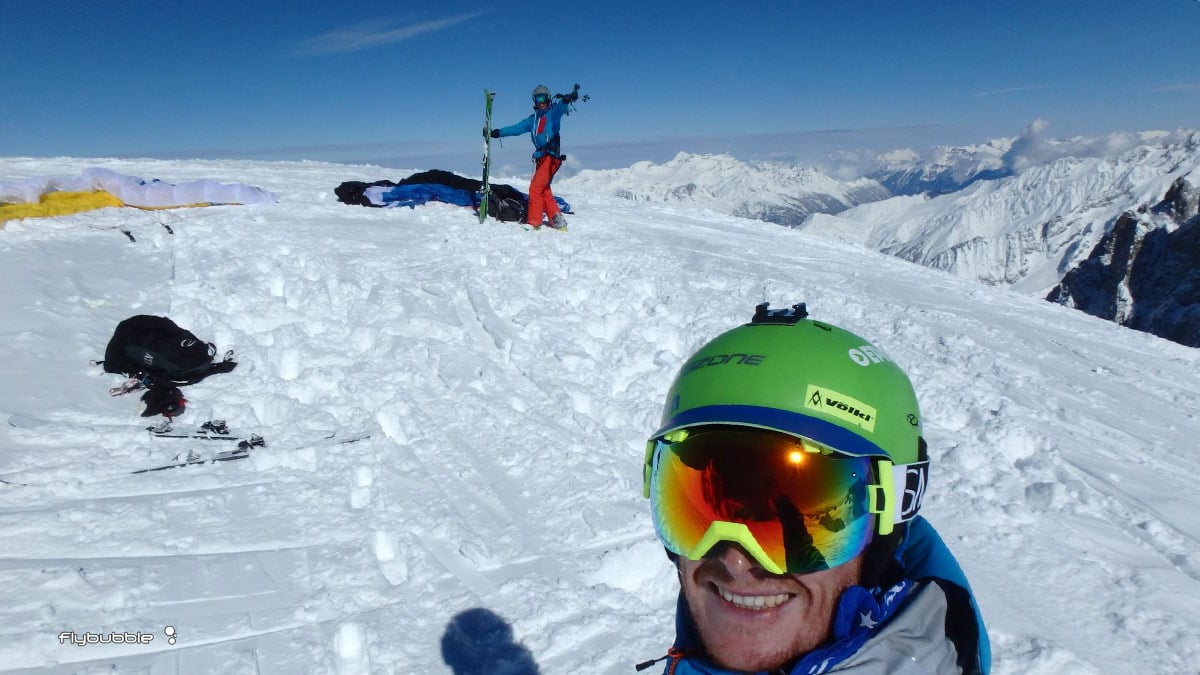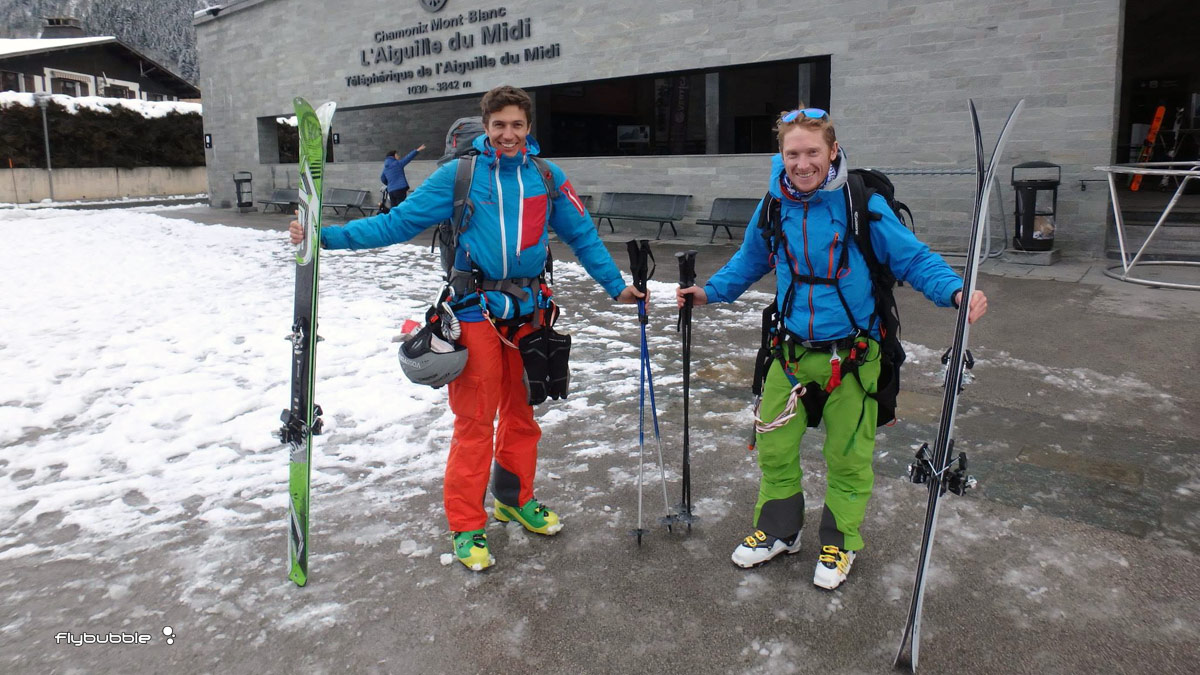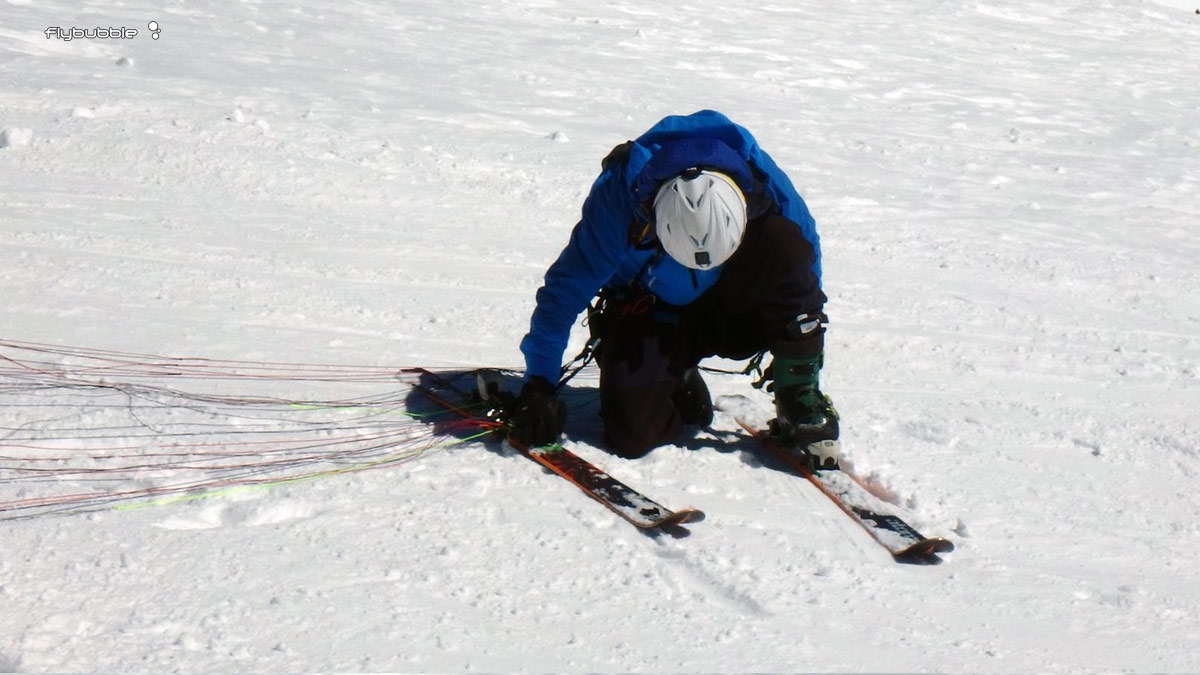
With less predictable snowfall and increasing numbers of free riders year on year, it’s easy to see why the discipline of speed riding is gaining in popularity. It enables access to remote and 'untracked' parts of the mountain that skiers and boarders can’t get to, it’s really easy to learn the basics if you’re a good skier and/or paraglider pilot, and of course it also looks exceedingly cool on film.
I started speed riding three winters ago, having had a solid basis in foot launching a 12m Fazer both on windy UK hills and in Chamonix during the summer. I love the light weight gear and the giddy feeling you get flying so fast and with such a huge rate of descent. Taking off and landing at high speed on skis, and then slowing down to carve turns in deep powder, before launching off an unskied cliff are just incredible feelings that remind me of my first hopes in paragliding.
 Riding in a well tracked off-piste area
Riding in a well tracked off-piste areaYou may already own a mini wing, or have one on the Christmas list – they’re cheap, light, and small to pack and everyone is getting them! The new harnesses can be around 100g, so often you won’t need more than a 25 litre pack that weighs 3kg total to cart the kit around. It would be natural to pack it in your ski gear for the next family holiday…
We sometimes struggle in paragliding with the conflicts of our surf bum/mountaineer desires for exposure and risk offset against the fact that we are an aviation discipline with all the rules, regulations and safety culture that goes hand in hand with this. This is no more true than in Speed Riding, where there is a fairly high accident rate, often involving untrained, unqualified, overconfident and underprepared pilots.
Exposure is dead easy to come by in this discipline! You can take a ski lift, walk 25m away from the piste and lob off into the unknown. It might be a risk 4 day, but who cares, you have a glider over your head and can fly away from any avalanche or terrain traps that you want to. You can fly over glaciers, crevasses and huge fields of untracked powder that’s just gagging to be skied. I’ve met many guys out in Chamonix speed riding with the absolute bare minimum of equipment, after all, they aren’t touring, or off piste skiing in a team, so why would they need any kit.
 Sometimes the snow is too good for speed riding
Sometimes the snow is too good for speed ridingFirst of all I would say that choosing to Speed Ride on a high avalanche risk day is not a way of buying safety. You can still trigger something, and even if you do fly away, you should think about those below you whom you haven’t seen and may even be skiing on a piste.
Secondly on the gear front, my 3kg glider bag gets significantly heavier when I include my transceiver, shovel, probe, touring skins, and if riding on the glacier - 30m of rope, a climbing harness worn under my Speed Riding harness, with ice screws and prussicks attached to it. If flying with a friend I’ll carry my radio and of course I’ll have a Spot or Delorme. This is the minimum amount of kit I might need to help in a rescue situation should I need to. I like to think that if you’re not prepared to help, then you’re only marginally more useful than the victim.
Of course, if you’re avalanched, the glider is going to hopefully stay partially out of the snow, but if buried, it’s definitely taking you with it. As such, I don’t wear an ABS, but it is something you may want to consider. Ski leashes have been used by “fast and light” ski tourers for a long time. These leashes are used instead of a brake, saving maybe 100g per ski. For us they are incredibly useful if we haven’t stepped in properly, or catch an edge while skiing, thus losing a ski or even worse, dropping it from height onto other skiers or members of the general public. Of course the pay-off is that you remain attached to a dangling ski, so the landing is not necessarily going to be pretty and some would argue there is a chance of breaking your leg as the ski remains clipped to your boot after suffering enough force to eject. The other handy ski attachment is a metre or so of ribbon tucked up your trouser leg. If you eject and aren’t leashed, it will greatly improve your chances of recovering your ski.
 Speed riding: laying out on low friction launches can be tricky if there's no wind
Speed riding: laying out on low friction launches can be tricky if there's no windWhen we’re paragliding, we are usually pretty interested in how much back protection our harness offers, and whether or not it’s certified. Strap ourselves onto a speed riding hanky, spending most of the flight either on the surface or within a few feet of it, we seem to forget what this back protection was all about. The harness may also be stuffed full of the chunks of metal I mentioned earlier and will almost certainly have ski poles in. Although it’s comfortable and lightweight to use these harnesses, it does seem a little crazy that we start to disregard this feature of our harnesses.
If I’m 'lapping' a spot with lift access then I’ll usually wear a spine protector as worn by motorcyclists or mountain bikers. If touring, then I may leave out this piece of kit, but my gear will be stowed inside a proper rucksack that I wear over the top of the shoulder less harness. Again as everything in the high mountains, it becomes a balance of safety vs bulk/weight.
The final piece of kit we don’t usually use is a reserve. There are a few reasons here, the operating height is so low and at such high speed, that a reserve will be useless should you have a deflation. Secondly, what’s a deflation? A speed wing loaded at +6kg/sm is almost impossible to collapse unless you’ve decided to go out on the most ridiculous of days, and if you did suffer a huge collapse, the thing would more than likely rotate and dive so quickly that you’d be planted in the snow within a second or two. There are occasions where friends of mine will fly with a front mounted reserve. These are generally very high cliff launches with significant vertical drop after the take off. These flights are more like ski launched fast paragliding than riding, and if you were to suffer the collapse, structural failure, or mid air collision, then the parachute may well save the day.
 Kitted up for a speed riding day on the glacier
Kitted up for a speed riding day on the glacierIf you come from a ski touring background, much of the mountain safety equipment will be familiar, if you are coming straight from piste skiing, it’s not only worth getting this gear, but also learning how to safely use it by attending avalanche talks in the ski area you visit or organising to go on a safety and crevasse rescue courses on poor weather days. Practice with friends, don’t be complacent and always have plans, back up plans and escape options for anything you’re doing.
Anything from an 18m mini wing down to an 8m speed rider will be an absolute blast to fly on skis, whether you just want to ski launch, or stay in contact for more of the flight. I flew a 12m wing for 3 seasons and have only recently moved down to a 9.5m. I’d suggest you approach cautiously as even if you’re comfortable with your 16m on a windy UK hill, you will fly with much greater ground speed in the mountains due to the lack of wind. The weight of any safety gear you bring and the drag of the skis will both also degrade your glide and increase your trim speed significantly and should be considered before you decide to downsize. Having sold my 12m glider, I am now on the lookout for a bigger wing to fly when I don’t have a long runway or super steep hill. Flying a very small wing is a blast, but it does start to limit your ability to speed ride whilst maintaining an ability to out fly the terrain when using shallower slopes.
 Putting skis on without poles is one of the biggest challenges
Putting skis on without poles is one of the biggest challengesTo aid planning your trip, lots of piste maps now have defined Speed Riding areas that are well clear of, but easily accessed from the lifts. You can also boot pack, or skin to get further from the crowds. Either way, you will often encounter other mountain users and should remember some basic rules. In France you must be 50m away from the pistes to launch and then maintain this separation from people and manmade structures while airborne, and 20m when “riding”. The rules vary slightly across Europe, so make sure you do your research before travelling.
The speed riding sport is still relatively new, even in paragliding terms. The gear, as well as the techniques and safety aspects are developing every season. It’s a cutting edge part of the sport that’s an absolute blast to learn – just give it the respect it deserves and enjoy the winter!

You might also enjoy Speed Flying Safety
